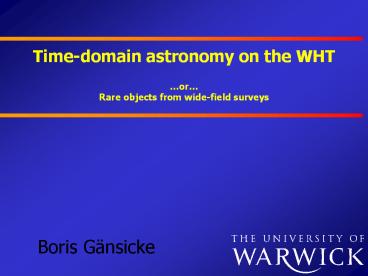Time-domain%20astronomy%20on%20the%20WHT - PowerPoint PPT Presentation
Title: Time-domain%20astronomy%20on%20the%20WHT
1
Time-domain astronomy on the WHT
or Rare objects from wide-field surveys
Boris Gänsicke
2
A few thoughts about time-domain astronomy
- flares
- flickering
- outbursts
- eruptions
- explosions
- eclipses / transits
- motion
(minutes hours) (msec minutes) (days
months) (months years) (months
years) (minutes hours) (minutes years)
- stellar activity
- stellar structure evolution
- binary evolution
- exo-planets
- accretion discs/processes
- cosmology
3
CK Vul Nova Vulpeculae 1670
- classical nova?
- late thermal pulse?
- merger?
- sub-Chandra SN?
(Hevelius 1670, Phil. Trans. 5, 2087)
4
Same constellation - 337 years later
IPHAS 6 weeks
AAVSO
IPHAS pre-eruption H?
(Wesson et al. 2008, ApJL 688, 21)
5
V458 Vul Nova Vulpeculae 2007
WHT/INT H? 2007-2009
IPHAS pre-eruption H?
(Wesson et al. 2008, ApJL 688, 21)
6
V458 Vul Nova Vulpeculae 2007
ISIS radial velocities
shortest-period PN nucleus Porb98.1min ? likely
a binary white dwarf
(Rodríguez-Gil et al. submitted)
7
The evolution of compact binary stars
70 brown dwarf donors
White dwarf / main sequence binaries are the
simplest CBs, yet population models and
observations used to disagree, e.g. no
brown-dwarf donor confirmed until 2006
8
SDSS10350551 The first definite BD donor
VLT spectroscopy eclipsing, P82min
(Southworth et al. 2006, MNRAS 373, 687)
WHT/ULTRACAM photometry M20.0550.002
(Littlefair et al. 2006, Science 314, 1578)
9
Another BD donor dynamically confirmed
ISIS/QUCAM
628 spectra at 30sec exposure time
WD radial velocity 34km/s
(Tulloch et al. 2009, MNRAS 397L, 32)
10
SDSS12575428 a WD NS/BH binary
- cool, high-mass white dwarf with a large radial
velocity amplitude - unseen companion is a NS or BH, at d48pc, this
is the closest - supernova remnant known
(Badenes et al. 2009, ApJ 707, 971)
11
SDSS12575428 a double white dwarf
ISIS spectroscopy
cool, very low-mass WD with a large
radial velocity amplitude, second high-mass
WD visible, rapidly rotating ? GWR progenitor
LISA-background source
(Marsh et al. 2010, ApJL submitted,
arxiv1002.4677)
12
Basic stellar physics
low-mass stars
white dwarfs
mass-radius relations are a strong prediction of
stellar structure evolution models, but poorly
probed/constrained by observations
(Ribas et al. MmSAI 79, 562 Parsons et al.
2010, MNRAS 402, 2591)
13
Basic stellar physics
low-mass stars
white dwarfs
mass-radius relations are a strong prediction of
stellar structure evolution models, but poorly
probed/constrained by observations
(Ribas et al. MmSAI 79, 562 Parsons et al.
2010, MNRAS 402, 2591)
14
Eclipsing WD low-mass companions
SDSS UKIDSS
extending the observed M-R relation to very
low stellar masses
SDSS UKIDSS
WDM6
WHT/ ACAM
(Burleigh et al. in prep., Gänsicke et al. in
prep)
15
Asteroseismology
WHT/ULTRACAM
PG0014027
(Jeffery et al. 2005, MNRAS 362, 66)
Pulsation frequency spectrum provides information
about mass, core composition, envelope mass,
rotation rate, magnetic field
16
V455 And the time-domain family pack
V455 AndHS23313905
Porb
- eclipsing
- brown dwarf
- pulsating WD
- rapidly rotating WD
- magnetic WD
- warped accretion disc
WHT/ULTRACAM
WD pulsations
WD spin
2xWD spin
(Araujo-Betancor et al. 2005, AA 430, 629)
17
Ultrafast spectroscopy
QUCam spectroscopy
15800 spectra 2sec exposure time no deadtime
(Steeghs et al. in prep)
18
The anomalous X-ray pulsar 4U 014261
WHT/ULTRACAM
RXTE
P8.687s
g27.2 i23.7
60000 0.48sec exposures, 0.025sec dead-time
optical / X-ray modulation is in phase, not
consistent with reprocession from a disc ? most
likely a magnetar
(Dhillon et al. 2005, MNRAS 363, 609)
19
X-ray reprocessing in Sco-X1
RXTE
WHT/ULTRACAM
11-16sec time X-ray/optical time-delay,
consistent with X-ray reprocessing on the
companion star
(Munoz-Diarias et al. 2007, MNRAS 379, 1637)
20
Planetary debris around white dwarfs
metal-rich debris from a tidally
disrupted asteroid, real-time evolution of the
debris disc is seen on time scales of years
(Gänsicke et al. 2006, Science 314, 1908)
21
Time domain astronomy wide-field surveys
- all examples discussed here are rare objects
found from - large-area surveys (e.g. PG, IPHAS, HQS,
SDSS)
- usually identified from painful long-slit
spectroscopic ID - programs
- SDSS was a paradigm shift co-ordinated deep
multi-band - imaging plus MOS follow-up (10000 white
dwarfs, 2000 WDMS - binaries, 290 cataclysmic variables, 40000
M-dwarfs)
- Future multi-colour surveys, in particular GAIA,
need a similar - follow-up strategy to achieve maximum
scientific impact, but
- all time-domain science needs continued access
to time-series - follow-up of new discoveries
22
MOS requirements
- low target density (a few to a few tens per
square degree) - ? multiplex with other target categories (as
SDSS did)
- broad wavelength coverage (380-920nm)
- intermediate spectral resolution (2000)
- complete down to V20 (GAIA limit)
23
Summary
- The ING caters for a large and healthy
community of - time-domain astronomers addressing a wide range
of - scientific problems
- Future surveys will continuously provide rare
examples of - stellar evolution (SDSS-III, PanSTARRS, and
ultimately - GAIA LISA)
- WHT is a leading and stable platform for
time-domain - astronomy on all time scales, with a range of
excellent - instruments ISIS, ISIS/QUCAM, ACAM, ULTRACAM
- need to make sure that that expertise is
kept































